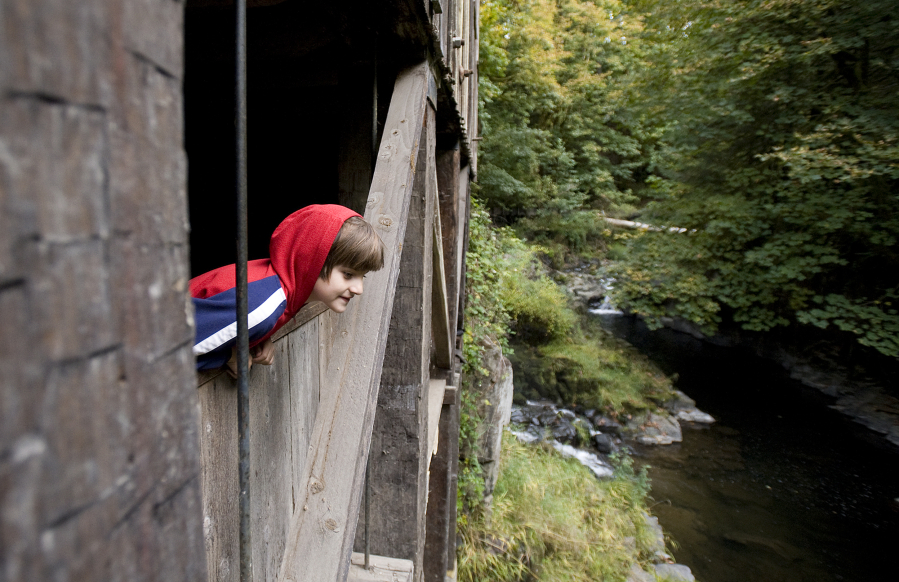ETNA — When Fred Schulz and David Couto want to diagnose whatever’s ailing the aged machinery inside the Cedar Creek Grist Mill, they stop what they’re doing and listen.
Their favorite, fancy cider press was clunking rhythmically on a recent morning, which meant that mechanical superintendent Schulz had some filing-down to do on the new cutter head he’d installed. This shredder-type press was made in the late 1800s by the Hocking Valley Manufacturing Company, an Ohio agricultural firm, and it’s an impressive piece of engineering — but anything that old is going to need maintenance, Schulz said.
Minutes later, Couto manned the mill’s central wheel while keeping an eye on the brightness of a bulb hanging from the ceiling; when it was just so bright but no brighter, Couto knew he was running the wheel at the right speed. But he wondered: “Is this thing growling? Do we need to add some grease?” Schulz came over and the two men tilted careful ears toward the mechanism before determining that it was singing smoothly.
“Working with machinery of this era is more art than science,” said Couto, president of the 300-member Friends of the Cedar Creek Grist Mill organization. “You develop a feel for it.” After several months of apprenticeship, that is — and in Couto’s case, one broken drive belt.
If You Go
• What: Apple cider pressing and bluegrass jam. Bluegrass musicians invited.
• When: 9 a.m. Oct. 28 until the apples run out (around 6 p.m.). Regular operating hours: 1 to 4 p.m. Saturdays and 2 to 4 p.m. Sundays.
• Where: Cedar Creek Grist Mill, 43907 N.E. Grist Mill Road, Woodland.
• Admission: Free.
• Contact: www.cedarcreekgristmill.org or 360-225-5832.
If you don’t have quite that long, stop by the Cedar Creek Grist Mill on Saturday anyway. You’ll get a feel for running at least some of this artistic machinery — and you’ll learn about all of it — as the mill hosts its annual “cider squeezin'” festival.
All day Saturday, starting at 9 a.m. and lasting until approximately seven tons of apples are transformed into about 750 gallons of fresh cider, you’ll be able to chat with grist mill volunteers about machinery and history, try your hand at loading apples and cranking wheels — and admire the ingenious network of water-powered belts, pulleys and axles that drive the millstone here.
That millstone won’t be put to work for Saturday’s cider squeezin’ outing — there are four apple presses for that — but it remains the star of the show here. “It’s a beautiful piece of machinery,” Couto said, and it can grind 650 pounds of flour in an hour. “The ingenuity of that age just amazes me.”
Refurbished by Friends
What’s now called the Cedar Creek Grist Mill was built as the Red Bird Mill in 1876 by George Woodham, but the venture remained iffy for years, with various owners coming and going, until a durable dam and water flume were built upstream to power the turbine that replaced the mill’s original water wheel.
Victor Roslund, a mechanic who was “a bit of a genius and a go-getter,” according to Schulz, lived upstairs in the mill for years while turning the downstairs into a machine shop. But Roslund didn’t just build parts, according to Schulz; he also built community by hosting dances and other social gatherings for north Clark County at the mill.
Decades later, the state bought the 12-acre property, removed the dam and added a fish ladder; in 1975 the site was listed on the National Register of Historic Places; and not long afterward the “Friends of” group formed to refurbish the sagging structure — meticulously using original axes and adzes to replace posts and beams authentically, Couto said.
Today, the mill is a working museum and, according to the Friends, the oldest building in the state of Washington that’s still doing exactly what it was built do to: mill grain, corn and even apples.
“It’s fun playing with a piece of history,” Couto said. “We’re in great danger of losing our history.”




